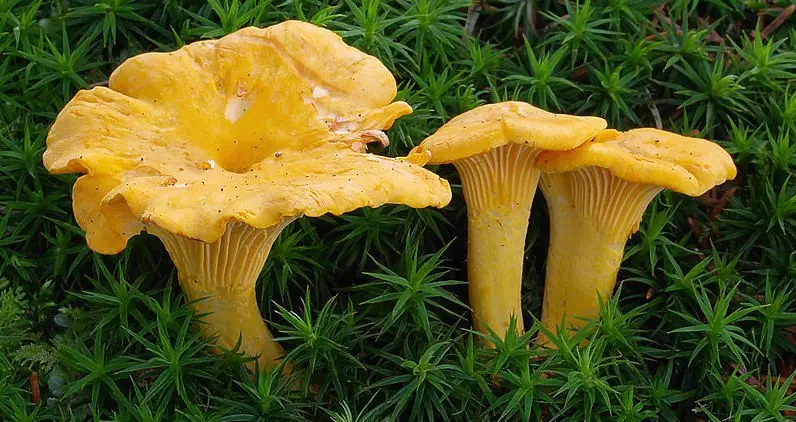Common chanterelle (Cantharellus cibarius)
- Division: Basidiomycota (Basidiomycetes)
- Subdivision: Agaricomycotina (Agaricomycetes)
- Class: Agaricomycetes (Agaricomycetes)
- Subclass: Incertae sedis (of uncertain position)
- Order: Cantharellales (Chanterella (Cantarella))
- Family: Cantharellaceae (Cantharellae)
- Genus: Cantharellus
- Type: Cantharellus cibarius (Common chanterelle)
- Chanterelle real
- Chanterelle yellow
- chanterelle
- Chanterelle yellow
- chanterelle
- Cockerel

Chanterelle ordinary, or Chanterelle real, or Petushók (lat. Cantharēllus cibārius) is a species of fungus in the chanterelle family.
Hat:
The chanterelle has an egg- or orange-yellow hat (sometimes fading to very light, almost white); in outline, the cap is first slightly convex, almost flat, then funnel-shaped, often of irregular shape. Diameter 4-6 cm (up to 10), the cap itself is fleshy, smooth, with a wavy folded edge.
Pulp dense, resilient, the same color as the hat or lighter, with a slight fruity smell and a slightly spicy taste.
spore layer in the chanterelle, it is folded pseudoplates running down the stem, thick, sparse, branched, of the same color as the cap.
Spore powder:
Yellow
Leg chanterelles are usually the same color as the cap, fused with it, solid, dense, smooth, narrowed towards the bottom, 1-3 cm thick and 4-7 cm long.
This very common mushroom grows from early summer to late autumn in mixed, deciduous and coniferous forests, at times (especially in July) in huge quantities. It is especially common in mosses, in coniferous forests.

The false chanterelle (Hygrophoropsis aurantiaca) is remotely similar to the common chanterelle. This mushroom is not related to the common chanterelle (Cantharellus cibarius), belonging to the Paxillaceae family. The chanterelle differs from it, firstly, in the deliberate shape of the fruiting body (after all, a different order is a different order), an inseparable hat and leg, a folded spore-bearing layer, and an elastic rubbery pulp. If this is not enough for you, then remember that the false chanterelle has an orange hat, not yellow, and a hollow leg, not a solid one. But only an extremely inattentive person can confuse these species.
The common chanterelle is also reminiscent (to some inattentive mushroom pickers) of the yellow hedgehog (Hydnum repandum). But to distinguish one from the other, just look under the hat. In the blackberry, the spore-bearing layer consists of many small, easily separated spines. However, it is not so important for a simple mushroom picker to distinguish a blackberry from a chanterelle: in the culinary sense, they, in my opinion, are indistinguishable.
Undisputed.
Read also: Useful properties of chanterelles









